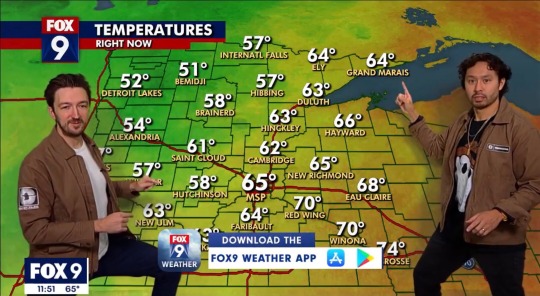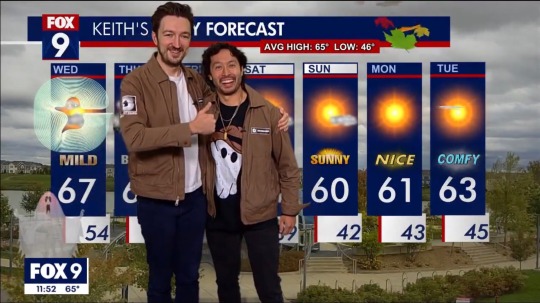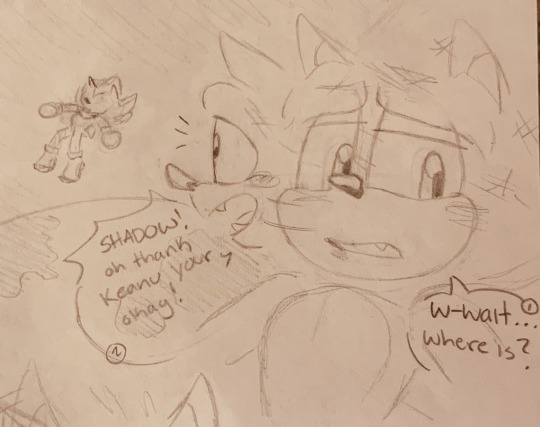#History and Forecast
Explore tagged Tumblr posts
Text
Can’t believe these two ghouls were on my local news this morning! If the YouTube thing doesn’t work out, it’s clear they can be weathermen. I think these screenshots prove that. @wearewatcher



#we are watcher#shane and ryan#ryan bergara#shane madej#minnesota#ghost files#puppet history#local news#was not expecting that#clearly experts#best weather forecast ever#idk what else to tag#made my day#they are in Minnesota tonight for a show#tickets available?#watcher
956 notes
·
View notes
Text
👽 Эволюция за 13 секунд. Нейросеть Luma AI сгенерировало процесс развития человечества от каменного века до 5000 года. По версии нейросети НЛО — это мы из будущего.
Неожиданный поворот 🤔
Evolution in 13 seconds. The Luma AI neural network generated the process of human development from the Stone Age to the year 5000. According to the neural network, UFOs are us from the future. An unexpected twist
источник
#эволюция#видео#нейросеть#процесс#нло#версия#человечество#будущее#история#прогноз#интеллект#evolution#video#neural_network#process#UFO#version#humanity#future#history#forecast#intelligence#русский тамблер#русский блог#русский пост#мотивация#жизнь#смыслы
52 notes
·
View notes
Text













Happy birthday Scottish weather presenter Carol Kirkwood born on May 29th, 1962 in Morar.
Born Carol MacKellaig, her parents ran a hotel at Morar, she has 7 sisters and brothers.
Carol was educated at Lochaber High School in Fort William before studying Commerce at Napier College in Edinburgh, qualifying with a BA. Carol joined the BBC’s secretarial reserve in London and it wasn’t long before she was presenting short slots on Radio Scotland, Radio 2 and 4.
She got married to hockey player Jimmy Kirkwood from Northern Ireland, they divorced in 2008. at the time Carol took a break from broadcasting, in recruitment and then as a training consultant for a management consultancy, returning to now defunct cable TV channel, Windsor TV, latterly called Wire TV, along with Sacha Baron Cohen, rejoining the BBC as a freelance reporter in 1993, also working on Independent television for Harlech Television (HTV) in a bi-monthly show Talking Issues.
In 1996 Carol started doing the job we know her best for, on The Weather Channel but after it closed down she underwent training under the guidance of the BBC at the Met Office, and returned to the BBC after her training, where sh has been ever since, working mainly on the morning news programmes. She presented the BBC’s The Weather Show and is also a regular contributor and reporter for The One Show.
Kirkwood won awards for best TV Weather Presenter in 2003, 2008, 2009 and 2012–2017.She received an Honorary Fellowship from Inverness College, part of University of the Highlands and Islands in 2015.
6 notes
·
View notes
Text

Day in Fandom History: February 19…
Steven and Greg have to get Connie home before a major snowstorm rolls into Beach City, but Steven selfishly wishes he could spend more time with Connie by stalling for time, resulting in trials and errors time after time. “Winter Forecast” premiered on this day, 10 Years Ago.
#Day in Fandom History#10 Years Ago#Steven Universe#Season 1#Episode 42#Winter Forecast#Cartoon#Animation
7 notes
·
View notes
Text
Roman Empire

1 note
·
View note
Text
Ajanta Pharma Q4 2025 Conference Call
Search Keyword: Ajanta Pharma share price, Ajanta Pharma stock today, Ajanta Pharma latest share news, Ajanta Pharma stock analysis, Ajanta Pharma share forecast, Ajanta Pharma price target, Ajanta Pharma stock performance, Ajanta Pharma share NSE, Ajanta Pharma share BSE, Ajanta Pharma equity share, Ajanta Pharma share long term, Ajanta Pharma stock for 2025, Is Ajanta Pharma a good buy, Ajanta…
youtube
View On WordPress
#Ajanta Pharma breakout level#Ajanta Pharma dividend history#Ajanta Pharma equity share#Ajanta Pharma latest share news#Ajanta Pharma moving average#Ajanta Pharma price target#Ajanta Pharma return on investment#Ajanta Pharma share BSE#Ajanta Pharma share chart#Ajanta Pharma share forecast#Ajanta Pharma share long term#Ajanta Pharma share NSE#Ajanta Pharma share price#Ajanta Pharma share trends#Ajanta Pharma stock analysis#Ajanta Pharma stock for 2025#Ajanta Pharma stock growth#Ajanta Pharma stock performance#Ajanta Pharma stock today#Ajanta Pharma stock valuation#Ajanta Pharma support resistance#Ajanta Pharma technical analysis#Ajanta Pharma volume analysis#Buy Ajanta Pharma share now#Fundamental analysis Ajanta Pharma#Is Ajanta Pharma a good buy#MACD Ajanta Pharma stock#Multibagger Ajanta Pharma stock#RSI of Ajanta Pharma#Youtube
0 notes
Text
Explore International Business Machines (IBM) stock price forecasts for 2025–2029, diving into financials, dividends, and competitive trends. #InternationalBusinessMachines #IBM #IBMstock #Stockpriceforecast #Dividendyield #Hybridcloud #AItechnology #Investmenttips #Techstocks #Stockmarketanalysis
#AI technology#Best time to buy IBM shares#Competitive Landscape#Dividend Yield#How to invest in IBM stock today#Hybrid cloud#IBM#IBM competitive analysis 2025#IBM dividend yield and buyback policy#IBM financial performance#IBM hybrid cloud and AI growth potential#IBM stock#IBM stock forecast and financial ratios#IBM stock price history and trends#IBM stock price prediction 2025–2029#International Business Machines#Investment#Investment Insights#Investment tips#Is IBM stock a good long-term investment#Should I buy IBM stock in 2025#Stock Forecast#Stock Insights#Stock market analysis#Stock Price Forecast#Tech stocks
0 notes
Text
NO BUT WAIT THAT LIGHTING CHANGE FRO. THE FIRST 3 PHOTOS!?!?! IDK IF ITS ON PURPOSE BUT THE MOOD SWING!!
🚨LONG POST WARNING⚠️
Me? Posting a long comic? Nooooo...
























My Sonic 3 Prediction🌠

My dumb of ass watching a scene that will never happen
#sonadow#movie sonic#sonic movie 3#movie shadow#sonic the hedgehog#shadow the hedgehog#sonic#sonic adventure 2#Yeah the weather forecast for this movie is looking pretty gay ngl#Is saving the guy you just met 24 hours ago who had framed you for crimes from falling to his doom sus??? <--- Sonics search history 😭#YOU CANNOT TELL ME HE WONT TRY TO SAVE HIS ASS HSJHSJSSHJ PLEASEEEE SEGA
2K notes
·
View notes
Text
For those curious, here’s the boys full interview from my local news channel’s YouTube:
youtube
#our morning weatherman interviewed them#and he did not disappoint#watcher#we are watcher#shane and ryan#shane madej#ryan bergara#ghost files#puppet history#ghost files live#local news#minnesota#fellow weirdos#just your average morning news and weather forecast#fox 9 news Minneapolis St Paul#Youtube
740 notes
·
View notes
Text
A very brief history of modern weather forecasting
The idea of a telegraph dates back as far as the 1700s, but it wasn't until the mid-1800s that they really took over. Before the telegraph, it wasn't possible to predict the weather reliably, because there wasn't a fast enough way to pass on information. Weather forecasting became organised in the late 1800s and forecasts came to radio and television in the early 1900s, when the use of radars in forecasting also began. The first weather satellite was launched in the United States in 1960 and nowadays they are widely used in predicting the weather.
#weather#weather forecast#weather forecasting#telegraph#satellite#radio#television#information technology#history#1700s#1800s#1900s#1960s
0 notes
Text

Go to wdef.com/votenow to make your choice in today's FriendInRoofing.com #weatherpoll of the day. Answer coming up on @WDEFNews12 #PrimeNewsAt7
#chattanooga weather#chief meteorologist austen onek#tennessee river valley#wdef-tv#wdef.com/weather#wdef#[email protected]#wdef chattanooga#wdef news 12#wdef.com#United States Weather Bureau#Daily Flying Weather Forecasts#Weather History
0 notes
Text
#caltech#cal tech#jennifer jahner#jahner#medieval#ptolemy#astrology#forecasting#covid#history#caltech magazine
0 notes
Text

Day in Fandom History: February 19…
Steven and Greg have to get Connie home before a major snowstorm rolls into Beach City, but Steven selfishly wishes he could spend more time with Connie by stalling for time, resulting in trials and errors time after time. “Winter Forecast” premiered on this day, 9 Years Ago.
#Day in Fandom History#9 Years Ago#Steven Universe#Season 1#Episode 42#Winter Forecast#Cartoon#Animation
2 notes
·
View notes
Text
NOAA “should be dismantled and many of its functions eliminated, sent to other agencies, privatized, or placed under the control of states and territories,” Project 2025 reads. The proposals roughly amount to two main avenues of attack. First, it suggests that the NWS should eliminate its public-facing forecasts, focus on data gathering, and otherwise “fully commercialize its forecasting operations,” which the authors of the plan imply will improve, not limit, forecasts for all Americans. Then, NOAA’s scientific-research arm, which studies things such as Arctic-ice dynamics and how greenhouse gases behave (and which the document calls “the source of much of NOAA’s climate alarmism”), should be aggressively shrunk. “The preponderance of its climate-change research should be disbanded,” the document says. It further notes that scientific agencies such as NOAA are “vulnerable to obstructionism of an Administration’s aims,” so appointees should be screened to ensure that their views are “wholly in sync” with the president’s.
Climate change is the single most important issue in the entirety of human history. One party wants to fight it. The other party wants to let the earth burn; in fact, they want to accelerate the fire.
9K notes
·
View notes
Text
So, reports of an unprecedented egg “shortage” are exaggerated. Nonetheless, egg prices — and egg company profits — have gone through the roof. Cal-Maine Foods — the largest egg producer and the only one that publishes its financial data as a publicly traded company — has been making more money than ever. It’s annual gross profits in the past three years have floated between 3 and 6 times what it used to earn before the avian flu epidemic started — breaking $1 billion for the first time in the company’s history. All of this extra profit is coming from higher selling prices, which have been earning Cal-Maine unprecedented 50-170 percent margins over farm production costs per dozen. Taking Cal-Maine as the “bellwether” for the industry’s largest firms — as people in the egg business do — we can be pretty confident that the other large egg producers are also raking in profits off the relatively small dip in egg production.
High persistent profits are an anomaly for the industry. Historically, egg producers have responded to avian flu epidemics—and the temporary rise in egg prices that often accompanies them—by quickly rebuilding and expanding their flocks of egg-laying hens. “Fowl plagues”—as these epidemics used to be called—have been with us since at least the 19th century. Most recently, large-scale avian flu epidemics hit egg farms in 2015 and 1983-1984. The egg industry responded to both of these destructive events by sprinting to rebuild and expand the egg-laying hen flock — something which checked price increases and ultimately made sure prices went back to pre-epidemic levels within a reasonable time.
As Cal-Maine Foods explained in its 2007 Annual Report: “In the past, during periods of high profitability, shell egg producers have tended to increase the number of layers in production with a resulting increase in the supply of shell eggs, which generally has caused a drop in shell egg prices until supply and demand return to balance.”
This time around, however, that’s not happening. Despite high profits, the egg industry has somehow maintained a stubborn deficit in egg production capacity. Hatcheries — the firms that supply hens to egg producers — have throttled the pipeline of hens instead of expanding it. According to the Egg Industry Center, the size of the flock of “parent” hens — the hens used by hatcheries to produce layer chicks for egg producers — plummeted from 3.1 million hens in 2021, to 2.9 million in 2022, to 2.5 million hens in 2023 and 2024.
Meanwhile, hatcheries have been hatching significantly fewer parent chicks to replace aging ones — nearly 380,000 (or 12 percent) fewer in 2022 compared to the year before, and even fewer parent chicks in 2023 and 2024 — leaving the parent flock older and more likely to produce eggs that fail to hatch. That could explain why, although hatcheries reported producing 125-200 million more fertilized eggs to the USDA in each of the last three years compared to 2021, the number of eggs they’ve placed in incubators and the number of chicks they’ve hatched from those eggs has either declined or stayed basically steady with 2021 levels in every year since.
As for egg producers themselves, you may be surprised to learn that they have added between 5 and 20 million fewer pullets to their farms in every one of the last three years than they did in 2021. As the USDA observed with some astonishment at the end of 2022, “producers—despite the record-high wholesale price [of eggs]—are taking a cautious approach to expanding production[.]” The following month, it pared down its table-egg production forecast for the entirety of 2023 on account of “the industry’s [persisting] cautious approach to expanding production.”
In other words, the only thing that the egg industry seems to have expanded in response to the avian flu epidemic is windfall profits — which have likely amounted to more than $15 billion since the epidemic began (judging by the increase in the value of annual egg production since 2022), and appear to have been spent primarily on stock buybacks, dividends, and acquisitions of rivals instead of rebuilding and expanding flocks. When an industry starts profiting more from *not* producing than from producing, it’s a sign that something isn’t right. It could be an innocent bottleneck. But when it lasts for three years on end with no relief in sight, it's usually a sign of something else that’s pervasive in America — monopolization.
As the coming installments in this series will detail, the fundamental problem in the egg supply chain today is the simple fact that every industry involved in turning an egg into a chicken and turning a chicken into an egg—from the breeders and hatcheries that create the hens to the producers who use the hens to make eggs—has been hijacked by one or two financier-backed corporations, with the incentives flipped from competing entities seeking to produce more eggs to an oligopoly trying to restrain the production of eggs.
On one end of the egg supply chain, you have two companies who control chicken genetics, the billionaire-owned Erich Wesjohann Group and the private-equity-backed Hendrix Genetics. Headquartered a short car trip apart in Cuxhaven, Germany, and Boxmeer, Netherlands, these private firms have systematically gained control over the supply of egg-laying hens to American producers over the past two decades by buying out or suppressing rivals and challengers. Today, no egg producer in this country can expand the number of hens in its flock — or even replace the hens it already has when they age out or die — without the cooperation of this duopoly. And, since the value of hens rises with the price of the eggs, when the price of eggs is high these two barons have a clear interest in keeping the supply of pullets to producers on a tight leash — so the high prices stick.
On the other end of the egg supply chain, you have the largest egg producer in the country and the world, Cal-Maine Foods.
Matt Stoller from his monopolisation/cartel report; something that has clicked recently is the way that business seeks to maximise profit margin over volume, which often leads to reducing production, brittle supply chains, high prices, and ultimately shortages.
in principle this isn't supposed to happen under capitalism, because someone earning high profit margins should be outcompeted by new entrants willing to earn slightly lower profit margins, until (in the perfect frictionless market) the rate of profit should be whittled down to the rate of risk free return (government interest rates?) plus epsilon (a little bit).
obviously this does happen in reality for a number of reasons, and the Problem of Profits is a fun question to dig into, but the problem of persistently high profits is a more concerning issue and appears to be growing across multiple industries.
antitrust law is supposed to prevent market concentration that leads to this outcome but has been toothless since the '90s, allowing dramatic consolidation across dozens of old industries (groceries, agriculture, pharmacies, television, newspapers) and of course new industries (tech giants).
government regulation often ends up favouring incumbents, but it seems that contractual arrangements between suppliers and industry bodies and buying agents to form tight cartels are a bigger problem: if egg prices are high you might think to start an egg farm, but you need to find someone who will sell you chickens and someone who will buy your eggs, when the industry is using every means at their disposal to cut off market access to new entrants.
and of course if you have access to the gargantuan amount of capital required to attempt a serious challenge to an established cartel, why exactly would you want to start a price war with them when you can instead find some other unprotected industry to buy up and establish a cartel of your own?
capitalism seems to have entered a phase of its development equivalent to WWI, where defensive operations by incumbents are more successful than offense by new ventures, keeping the battle lines frozen in place (presumably the soldiers dying in their millions would be workers and consumers in this analogy).
4K notes
·
View notes
Text
No paywall version here.
"Two and a half years ago, when I was asked to help write the most authoritative report on climate change in the United States, I hesitated...
In the end, I said yes, but reluctantly. Frankly, I was sick of admonishing people about how bad things could get. Scientists have raised the alarm over and over again, and still the temperature rises. Extreme events like heat waves, floods and droughts are becoming more severe and frequent, exactly as we predicted they would. We were proved right. It didn’t seem to matter.
Our report, which was released on Tuesday, contains more dire warnings. There are plenty of new reasons for despair. Thanks to recent scientific advances, we can now link climate change to specific extreme weather disasters, and we have a better understanding of how the feedback loops in the climate system can make warming even worse. We can also now more confidently forecast catastrophic outcomes if global emissions continue on their current trajectory.
But to me, the most surprising new finding in the Fifth National Climate Assessment is this: There has been genuine progress, too.
I’m used to mind-boggling numbers, and there are many of them in this report. Human beings have put about 1.6 trillion tons of carbon in the atmosphere since the Industrial Revolution — more than the weight of every living thing on Earth combined. But as we wrote the report, I learned other, even more mind-boggling numbers. In the last decade, the cost of wind energy has declined by 70 percent and solar has declined 90 percent. Renewables now make up 80 percent of new electricity generation capacity. Our country’s greenhouse gas emissions are falling, even as our G.D.P. and population grow.
In the report, we were tasked with projecting future climate change. We showed what the United States would look like if the world warms by 2 degrees Celsius. It wasn’t a pretty picture: more heat waves, more uncomfortably hot nights, more downpours, more droughts. If greenhouse emissions continue to rise, we could reach that point in the next couple of decades. If they fall a little, maybe we can stave it off until the middle of the century. But our findings also offered a glimmer of hope: If emissions fall dramatically, as the report suggested they could, we may never reach 2 degrees Celsius at all.
For the first time in my career, I felt something strange: optimism.
And that simple realization was enough to convince me that releasing yet another climate report was worthwhile.
Something has changed in the United States, and not just the climate. State, local and tribal governments all around the country have begun to take action. Some politicians now actually campaign on climate change, instead of ignoring or lying about it. Congress passed federal climate legislation — something I’d long regarded as impossible — in 2022 as we turned in the first draft.
[Note: She's talking about the Inflation Reduction Act and the Infrastructure Act, which despite the names were the two biggest climate packages passed in US history. And their passage in mid 2022 was a big turning point: that's when, for the first time in decades, a lot of scientists started looking at the numbers - esp the ones that would come from the IRA's funding - and said "Wait, holy shit, we have an actual chance."]
And while the report stresses the urgency of limiting warming to prevent terrible risks, it has a new message, too: We can do this. We now know how to make the dramatic emissions cuts we’d need to limit warming, and it’s very possible to do this in a way that’s sustainable, healthy and fair.
The conversation has moved on, and the role of scientists has changed. We’re not just warning of danger anymore. We’re showing the way to safety.
I was wrong about those previous reports: They did matter, after all. While climate scientists were warning the world of disaster, a small army of scientists, engineers, policymakers and others were getting to work. These first responders have helped move us toward our climate goals. Our warnings did their job.
To limit global warming, we need many more people to get on board... We need to reach those who haven’t yet been moved by our warnings. I’m not talking about the fossil fuel industry here; nor do I particularly care about winning over the small but noisy group of committed climate deniers. But I believe we can reach the many people whose eyes glaze over when they hear yet another dire warning or see another report like the one we just published.
The reason is that now, we have a better story to tell. The evidence is clear: Responding to climate change will not only create a better world for our children and grandchildren, but it will also make the world better for us right now.
Eliminating the sources of greenhouse gas emissions will make our air and water cleaner, our economy stronger and our quality of life better. It could save hundreds of thousands or even millions of lives across the country through air quality benefits alone. Using land more wisely can both limit climate change and protect biodiversity. Climate change most strongly affects communities that get a raw deal in our society: people with low incomes, people of color, children and the elderly. And climate action can be an opportunity to redress legacies of racism, neglect and injustice.
I could still tell you scary stories about a future ravaged by climate change, and they’d be true, at least on the trajectory we’re currently on. But it’s also true that we have a once-in-human-history chance not only to prevent the worst effects but also to make the world better right now. It would be a shame to squander this opportunity. So I don’t just want to talk about the problems anymore. I want to talk about the solutions. Consider this your last warning from me."
-via New York Times. Opinion essay by leading climate scientist Kate Marvel. November 18, 2023.
#WE CAN DO THIS#I SO TRULY BELIEVE THAT WE CAN DO THIS#WE CAN SAVE OURSELVES AND THE WORLD ALONG WITH US#climate crisis#united states#climate change#conservation#hope posting#sustainability#climate news#climate action#climate emergency#fossil fuels#global warming#environmentalism#climate hope#solarpunk#climate optimism#climate policy#earth#science#climate science#meteorology#extreme weather#renewable energy#solar power#wind power#renewables#carbon emissions#climate justice
33K notes
·
View notes